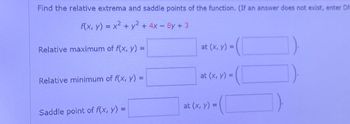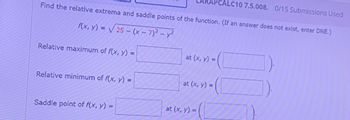
College Algebra
1st Edition
ISBN: 9781938168383
Author: Jay Abramson
Publisher: OpenStax
expand_more
expand_more
format_list_bulleted
Question

Transcribed Image Text:Find the relative extrema and saddle points of the function. (If an answer does not exist, enter DN
f(x, y) = x² + y²+4x-8y + 3
Relative maximum of f(x, y) =
at (x, y) =
Relative minimum of f(x, y) =
at (x, y) =
Saddle point of f(x, y) =
at (x, y) =

Transcribed Image Text:ALC10 7.5.008. 0/15 Submissions Used
Find the relative extrema and saddle points of the function. (If an answer does not exist, enter DNE.)
f(x, y) = √√√25-(x-7)² - y2
Relative maximum of f(x, y) =
at (x, y) =
Relative minimum of f(x, y) =
at (x, y) =
Saddle point of f(x, y) =
at (x, y) =
Expert Solution
This question has been solved!
Explore an expertly crafted, step-by-step solution for a thorough understanding of key concepts.
Step by stepSolved in 2 steps with 8 images

Knowledge Booster
Similar questions
- find the local extrema and saddle point (if its exist)arrow_forwardUse the second derivative test to identify any critical points and determine whether each critical point is a maximum, minimum, saddle point, or none of these. f(x, у) %3D —х2 - бу? + 12х — 36у — 87 (х, у, 2) %3D maximumarrow_forwardDetermine the local min/max or saddle points off(x, y) = x^2 + 2y^2 − 4x + 4y + 6 and make sure you state both the points at which they occur and the function values of f at those points.arrow_forward
- Use the Second Derivatives Test to find the local maximum and minimum values and saddle points of f(x,y)=x-y+x^2+xy^2arrow_forward2. Examine the function f(x, y) = x' - 15xy +y³ +7 for relative extrema and saddle points. a. saddle point: (0, 0, 7): relative minimum: (5, 5, –118) b. relative minimum: 0. 0, ); relative maximum: (5, 5, -118) c. saddle points: (0, 0, 7) (5, 5, –118) d. saddle point: (5, 5, –118). relative minimum: (0, 0, 7) (5, 5,-118). relative maximum: (0, 0, 7) e. relative minimum:arrow_forwardFind all relative extremes and any saddle pointsarrow_forward
arrow_back_ios
arrow_forward_ios
Recommended textbooks for you
 Algebra & Trigonometry with Analytic GeometryAlgebraISBN:9781133382119Author:SwokowskiPublisher:Cengage
Algebra & Trigonometry with Analytic GeometryAlgebraISBN:9781133382119Author:SwokowskiPublisher:Cengage


Algebra & Trigonometry with Analytic Geometry
Algebra
ISBN:9781133382119
Author:Swokowski
Publisher:Cengage